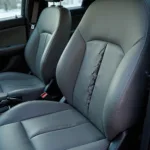A cracked or broken car window is not only an eyesore, but it also poses a serious safety hazard. While a permanent fix is always recommended, temporary car window repair can be a lifesaver in a pinch. Whether you’re waiting for an appointment with a professional or stranded on the side of the road, knowing how to temporarily fix a car window can save you time, money, and potential injuries.
Understanding the Urgency: Why Temporary Car Window Repair Matters
Driving with a damaged car window can be extremely dangerous. Apart from the obvious security risk of leaving your car vulnerable to theft, a compromised window also exposes you and your passengers to the elements, including rain, wind, dust, and even flying debris. Moreover, driving at high speeds with a cracked window can cause the damage to worsen rapidly, potentially leading to a complete shatter. This situation can be extremely dangerous, especially if you’re on a busy highway. Temporary car window repair provides a barrier against these risks, allowing you to drive safely until you can have the window professionally replaced.
Assessing the Damage: When a Temporary Fix is Appropriate
Before diving into temporary car window repair solutions, it’s crucial to assess the extent of the damage. While minor cracks and chips can often be temporarily patched up, severe damage with large holes or shattered glass requires immediate professional attention. Attempting a DIY fix on severely damaged windows can be ineffective and even dangerous.
Effective DIY Solutions: Temporary Car Window Repair Methods
Here are some readily available materials that can be used for temporary car window repair:
1. Packing Tape: Your Quick Fix on the Go
Packing tape is a readily available and surprisingly effective temporary solution for small cracks and chips.
- Clean the area: Thoroughly clean the area around the damage with a glass cleaner and a microfiber cloth to ensure the tape adheres properly.
- Apply the tape: Cut a piece of packing tape slightly larger than the crack and apply it firmly over the damaged area, ensuring there are no air bubbles.
- Reinforce for strength: Apply additional layers of tape, overlapping each layer by about half an inch, to create a stronger seal.
2. Plastic Sheeting: Providing Wider Coverage
For larger cracks or holes, plastic sheeting offers a more robust temporary fix.
- Cut to size: Measure and cut a piece of heavy-duty plastic sheeting slightly larger than the damaged area.
- Secure with tape: Apply packing tape or duct tape along the edges of the plastic sheeting, securing it firmly to the car window frame. Overlap the tape onto both the plastic and the window frame for a stronger hold.
3. Specialized Car Window Repair Kits: Your Go-To Solution
Car window repair kits are specifically designed for temporarily fixing minor cracks and chips.
- Follow the instructions: Each kit comes with detailed instructions. Follow them carefully for optimal results.
- Apply the resin: Most kits involve applying a resin to the damaged area using an applicator. The resin hardens when exposed to sunlight, effectively sealing the crack.
Seeking Professional Help: When and Why It’s Essential
While temporary car window repair methods can provide immediate relief, they are not permanent solutions. It’s crucial to remember that temporary fixes are meant to buy you time until you can get your window professionally repaired or replaced. Here’s why:
- Safety First: Temporary fixes may not withstand heavy rain, extreme temperatures, or high-speed driving.
- Clarity of Vision: DIY patches can obstruct your view, potentially compromising your safety on the road.
- Long-term Solution: Professional repair ensures a durable, safe, and aesthetically pleasing result.
Conclusion
Temporary car window repair can be a practical solution in emergencies, providing a temporary shield against the elements and potential theft. However, it’s crucial to remember that these are temporary measures. Always prioritize your safety and seek professional repair or replacement as soon as possible to ensure optimal visibility and security on the road.

